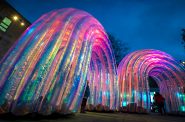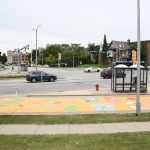Checking in on Milwaukee’s WikiProject for Public Art
Who is that man? The tall bronze one on the pedestal in Juneau Park, wearing a tunic, holding one hand on his hip and shielding his eyes while he looks off to the distance?
And what are those large stones in front of the Reuss Federal Building, the ones that are sort of blueish-gray, rounded and twisting? Can you sit on them and have lunch?
If these questions have vexed you about our public art landscape, your answers will soon be at hand. In late March, the Milwaukee Arts Board, in conjunction with WikiProject Public Art , launched an endeavor to document Milwaukee’s public art.
“Public art needs to be accessible and Milwaukee has cultivated so many pieces that cataloging them in this way seems a perfect marriage of the art and the online opportunities for sharing,” says Alderman Michael Murphy, chair of the Arts Board.
This noble undertaking is new to Milwaukee, and is also happening in other cities such as Washington, D.C. and Indianapolis.
Interested citizen authors are encouraged to choose a sculpture to research from this list and, following a standard Wikipedia format, compose an article informing readers about the work. Generally, it’s not complex art historical research, but a casual overview that starts with basic information. On the best pages, more in-depth information concerning context and meaning is addressed, along with earlier news articles and publications about the piece.
The devil can be very much in the small details, which undercut the credibility of the information the authors have put together. For example, the entry on the notorious Bronze Fonz notes that it is a life-sized sculpture, which may be true if Henry Winkler is a very petite man. More puzzlingly, the dimensions listed under the picture indicate an even more diminutive size (65 cm, or 26 in).
The sculpture of blueish-gray stones in front of the Reuss Federal Building are Helaine Blumenfeld’s Family. The Wikipedia entry describes the interactive and mobile nature of the piece: “The sculptures are movable and the public is encouraged to climb, touch and rearrange the works periodically.”
Before we get ideas that lunchtime crowds should spontaneously redecorate the plaza by moving the stones, it’s useful to look at the source of this information. Yes, the sculpture can be sat upon and touched, and while the sculpture can be rearranged, it’s out of the purview of the public and better left to the professionals.
As it continues to grow, the project will undoubtedly convey a lot of information and give Milwaukeeans a better understanding of the art in our communal backyard. It’s not a perfect resource yet, but the online world of research and information offers astonishing possibilities (and it’s worth noting that the project is seeking editors).
One hopes and imagines it will get better and better. We’ll continue watching as the online mosaic of sculpture in Milwaukee is filled in, giving us a broader and more accessible picture than ever before of public art in the city.
By the way – the answer to the question of who is that man in Juneau Park? It’s explorer Leif Ericson, and you can read about him here.
Art
-
Winning Artists Works on Display
 May 30th, 2024 by Annie Raab
May 30th, 2024 by Annie Raab
-
5 Huge Rainbow Arcs Coming To Downtown
 Apr 29th, 2024 by Jeramey Jannene
Apr 29th, 2024 by Jeramey Jannene
-
Exhibit Tells Story of Vietnam War Resistors in the Military
 Mar 29th, 2024 by Bill Christofferson
Mar 29th, 2024 by Bill Christofferson
























Thanks for spreading the word about the project, and for suggesting corrections to the existing articles. With more help, the collection of articles about Milwaukee public’s art will become more informative and inclusive.
Thanks, Kat, for the Wikipedia piece! Of course the beauty of Wikipedia
is that it is designed to refine content: the “citizen authors” are also
“citizen editors.”
This project (and Wikipedia)will continue to improve in relation to its ability to attract more expertise to it, and I am very grateful that your article takes the project, and public art, seriously.
What a great project! So glad this is being done. Thanks to all who are working so hard behind the scenes.
Please contribute with a piece on your favorite Milwaukee sculpture.
Try to make it factual because it WILL be edited.
A big smile for the entry that thought an individual could move Norwegian blue granite, the material of “The Family”, without a huge crane!
What a GREAT idea, including the follow-up notion that the entries will be edited. Can’t wait to read these. I had the great pleasure of knowing the amazing Joanne Johnson who worked tirelessly in the Milwaukee area public art arena. While she has passed on to art heaven, I know she is happy about this project and would give it her blessing.